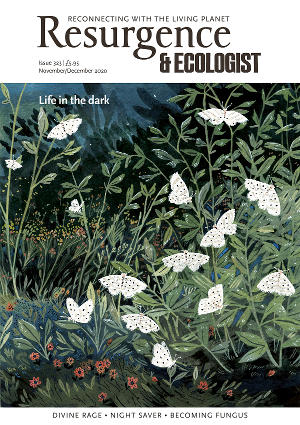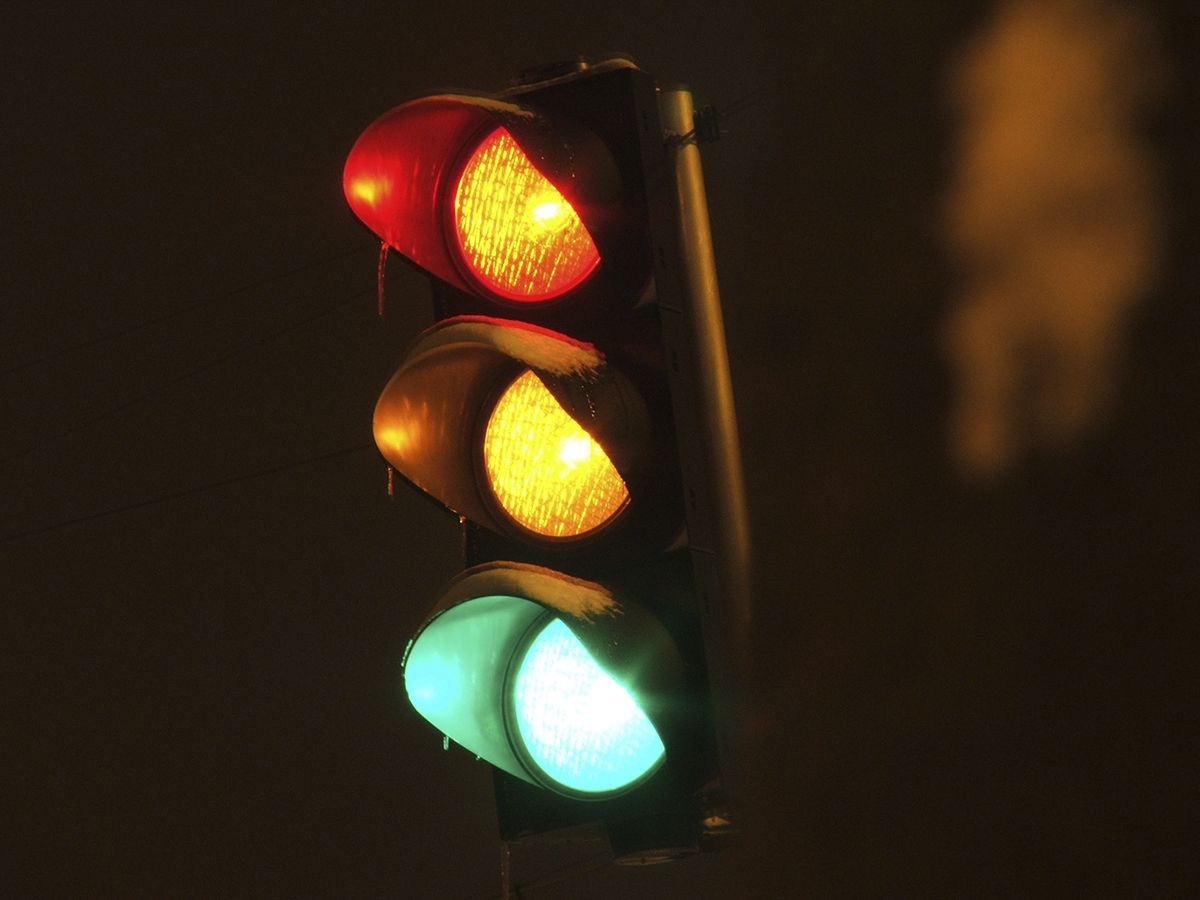For aeons, humans have tried to push the night away. As the sun lowers and darkness begins to rise at a minute-hand tick from valley and meadow to crag and peak, we seek shelter and light. First, it was through simple flames, the burning bodies of oily seabirds, fireflies gummed to toes. Then came the thin flicker from rushlights, the splutter of fatty candles, followed by the steady, brightening glow of gas light and electricity.
Little by little, light has grown, becoming not just a means of navigation and a source of comfort, but also a beacon of civilisation. Contemporary pictures of the UK taken at night by weather satellites show an archipelago that is rashed with light. The major cities – London, Birmingham, Manchester, Nottingham, Liverpool – stand out like welts, while even the darker spots are webbed with lurid knots of lamp-guarded roads. The nights of stars and moonlight, sources of myth, magic and meaning, a way of giving ourselves scale within the enormousness and beauty of the universe, have largely been replaced by a sickly veil of human luminescence. Night, with its slow rhythms and subtle shades, has become little more than a darker, duller kind of day.
A study by the Campaign to Protect Rural England, based on night-time images taken in 2015, found that just 21.7% of England has what could be considered to be pristine, unpolluted skies. In 2016, research published in the journal Science Advances by an international team of scientists revealed that the Milky Way, described by John Milton as “a broad and ample rode whose dust is Gold / And pavement Starrs”, was no longer visible to 77% of the UK population. Speaking at the time, the report’s lead author, Fabio Falchi, said the situation was a “cultural loss of unprecedented magnitude”.
As Falchi suggests, the chance to stare up at starlight, at light that is older than us, older than our gods, to have an experience that has been shared across millennia, is fundamentally human. But there are other reasons why dark skies are important. In short, the way we light up our world is having a huge impact on wildlife.
Writing in the introduction to their groundbreaking 2006 book, Ecological Consequences of Artificial Night Lighting, Catherine Rich and Travis Longcore posed a question. “What”, they said, “if we woke up one morning only to realize that all of the conservation planning of the last thirty years told only half the story – the daytime story? Our diurnal bias has allowed us to ignore the obvious, that the world is different at night and that natural patterns of darkness are as important as the light of day to the functioning ecosystems.”
The collection of papers that followed seemed to suggest just this possibility, examining how light affected mammals, birds, reptiles, amphibians, fish, invertebrates and plants. Migration, breeding, life and death were all found to be directly influenced by artificial lighting.
Then, in 2019, a comprehensive review of 150 scientific studies of artificial light’s impact on ecosystems painted the clearest picture yet: the electric light we use to chase away the dark is affecting every aspect of insect life – luring moths to death from exhaustion, changing breeding patterns, obscuring mating signals, spotlighting prey for predators, and disrupting the entire ecosystem up and down the food chain. A statement from the lead authors, published in the journal Biological Conservation, said: “We strongly believe artificial light at night – in combination with habitat loss, chemical pollution, invasive species, and climate change – is driving insect declines.”
The impact of artificial light on insects is particularly significant given the importance of invertebrates to ecosystems. A global review on insect declines, following on from studies of population collapses in Germany and Puerto Rico, stated that an absence of insects would have “devastating consequences” for life on Earth. Given that around half of the millions of species of insects on this planet are nocturnal (with diurnal species also impacted by artificial light when they are resting), it is not overstating the case to say that how we are illuminating our world is playing a part in its destruction.
It wasn’t until I was researching and writing my most recent book, Under the Stars, that I really noticed just how many lights there are in the UK and how hard it is to avoid them. Walking at night close to where I live in Suffolk and hankering for a scrap of darkness, I experienced a little of what it must feel like to be a nocturnal creature in a modern landscape. Empty offices, shops and supermarkets glowed, creating light domes that went far beyond their earthly boundaries. Car-free roads, verges and hedgerows were lit with street lamps whose light spilled like floodwater into green spaces and areas set aside as wildlife corridors. Further afield, in small, once dark villages, my footsteps were marked by the flash-gun flare of security lights, while gardens were lit by sunlight-strength LEDs. For me the transformation of a nightscape into something orange-hued and dull was frustrating, but for nocturnal species the night has become a fearscape: a matrix of glow and glare that makes natural behaviour and navigation all but impossible.
However damaging artificial lights are to the circadian clocks of humans, they are normal. We have grown up in a world of light. It clings to the nocturnal hours like a second skin. The baseline for what we expect at night (starlight, moon shadows) has over time warped and fallen to new lows. While this means we do not notice the brightness, we are also unused to the darkness; we think it is darker than it really is. Longcore’s latest research involves trying to demonstrate how animals see nightscapes. By taking photographs at night and increasing the exposure, he creates an image that represents what creatures capable of seeing in low light experience. During a conversation on Skype, he showed me several pictures he had taken from the Hollywood Hills. The first showed a dark landscape with a view over a sea of lights. The second, enhanced in line with the visual capabilities of a mountain lion, was a glimpse of a bright, new world. The city was no longer a twinkling in the distance but an impenetrable, blazing wall. The mountain, the trail, both invisible in the first shot, were lit up as if it were day.
It is easy to be downbeat, to think of the glow of artificial lights that cover so much of our country, so much of the globe, as the searchlights of the Anthropocene; the sparks from the starting gun of ecological collapse. But unlike plastic or radioactive materials, light doesn’t linger in the bellies of whales or lodge in the Earth’s strata. Turn off a light, and it will simply disappear. Of course, this doesn’t mean all lights need to be turned off at night, but rather that we need to re-evaluate how and where light is used. What’s more, we need to do it quickly, because we are losing night at the speed of light.
NIGHT SAVER
To take action on light pollution in England, there is a very useful tool to hand. An interactive map developed by CPRE, the countryside charity, and consultants LUC allows people to look up light pollution and dark skies in their local area. “They are based on satellite data captured throughout September 2015 at 1.30am, so the light spilling up into the night sky,” Emma Marrington, Rural Communities Enhancement Lead for CPRE, told Resurgence & Ecologist. “They were published in summer 2016 and remain the most comprehensive maps of England, with detailed maps of English counties, districts, national parks and Areas of Outstanding Natural Beauty. The maps and data are very much used by councils, community groups, consultants and people who want to understand more about the night sky in their area.” The maps can be used to protect and enhance dark skies in a variety of ways: as evidence to shape future development projects, to lobby councils or raise awareness among MPs, and as educational resources for schools. They can also be used to locate the nearest area of dark skies to help people escape light pollution for some unadulterated stargazing.
For more information: tinyurl.com/cpre-light-pollution








